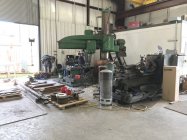Leaving this here as a reminder to not jump to conclusions but see edit below.
I purchased a TBAS for my lathe, have set it up and, using a barrel that needs to be set back, I dialed in the muzzle end to get some experience.
I am sure that my lathe, a Grizzly G4003G, is too small for this chuck or very marginal at best. I followed the instructions that came with the chuck and did purchase one of SSGs range rods as well.
The words that are used here to describe the kinds of adjustments are from SSG.
The instructions state that radial alignment should be set first. That means without turning the chuck you should set the work piece to be level when jogging the carriage from one end of the range rod to the other. You do this in pairs and split the error between the pairs that are 180 degrees apart. So 1 & 3 followed by 2 & 4. So, you will not end up with no dial movement when jogging the indicator from one end to another but the same movement between the 180 degree pairs. This is the same as using the rear spider to get the far end of the range rod running with minimal or no runout. If you think like a machinist, and, I don’t, this is probably relatively easy. I had to write notes about which way to turn the adjustments and some admittedly easy math to split the error between the pairs. I was able to get close but not as close as I would like. About .001 was as close as I could get.
Next was to set the axial alignment. That means jogging the indicator close to the chuck, rotating it and adjusting it, just like on a set-tru, to get the workpiece running true. I expected that when I got that perfect that it was going to be perfect on the far end as well, but it was nowhere close—.004 off. I don’t mean .0004, I mean 4 thousandths.
After messing around with this for a while, I decided to dial in the way I normally do which is by rotating the chuck and getting an inboard section of the rod and an outboard section of the rod running true and then transitioning to the long stem Interapid for final adjustments using the direct indication method. I found that this worked perfectly fine and was relatively easy to accomplish. Could easily attain almost no discernible needle movement on the Interapid which I choose to interpret as less than +/- .0001.
I am waiting on a reamer that should be here any day and am looking forward to trying the TBAS out for real. I do like that all adjustments are made at the chuck. I also like that you set the jaws on the barrel once and are sure that they are not too tight or loose when ready to part, thread and ream. It is a very nicely made chuck. I got the Gator 6-jaw and have read some unflattering reviews of it but mine is perfectly fine for this job. Will report back when I’ve gained more experience.
Hank
EDIT: I tried this again tonight starting from scratch and using a different barrel. Experience is a good thing! I also rewrote the instructions to make them clearer to me. I did approach this with the knowledge I gained from the first dial-in and was much more disciplined about what I wrote down and was more intentional about all adjustments setting precise targets for each. Understanding that you have to overshoot the radial adjustments to get what you want reduces the iterations significantly.
From loading the barrel into the chuck to completing the dial-in as described in the instructions was 35 minutes. This resulted in all measurements ≤ .00025 TIR. From that point I removed the SSG rod and direct indicated using the Interapid. 10 more minutes and < .0002 TIR both inboard and outboard. Ready to thread tenon. I am sure the next dial-in will be faster.
Thanks for the long read.
Hank












